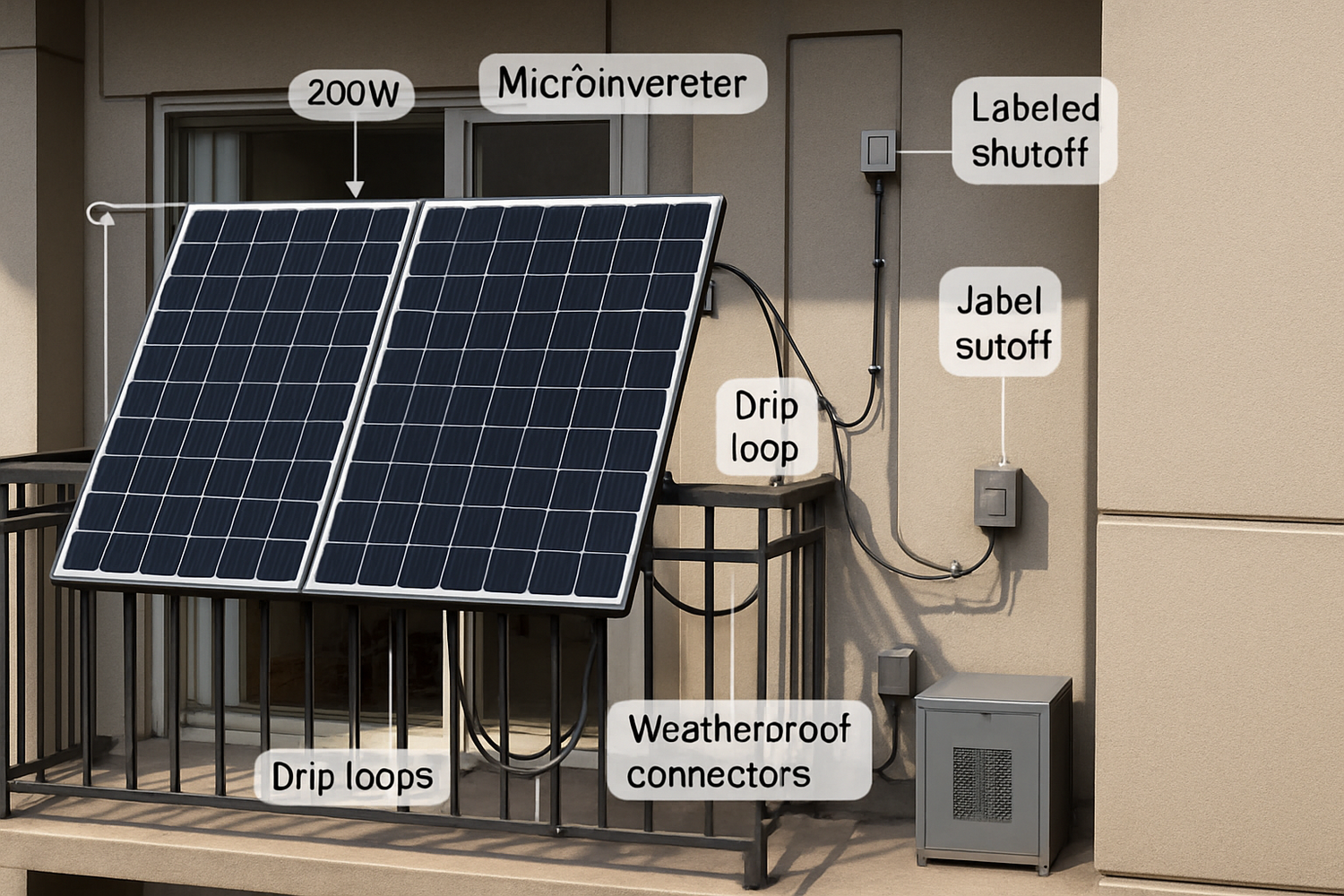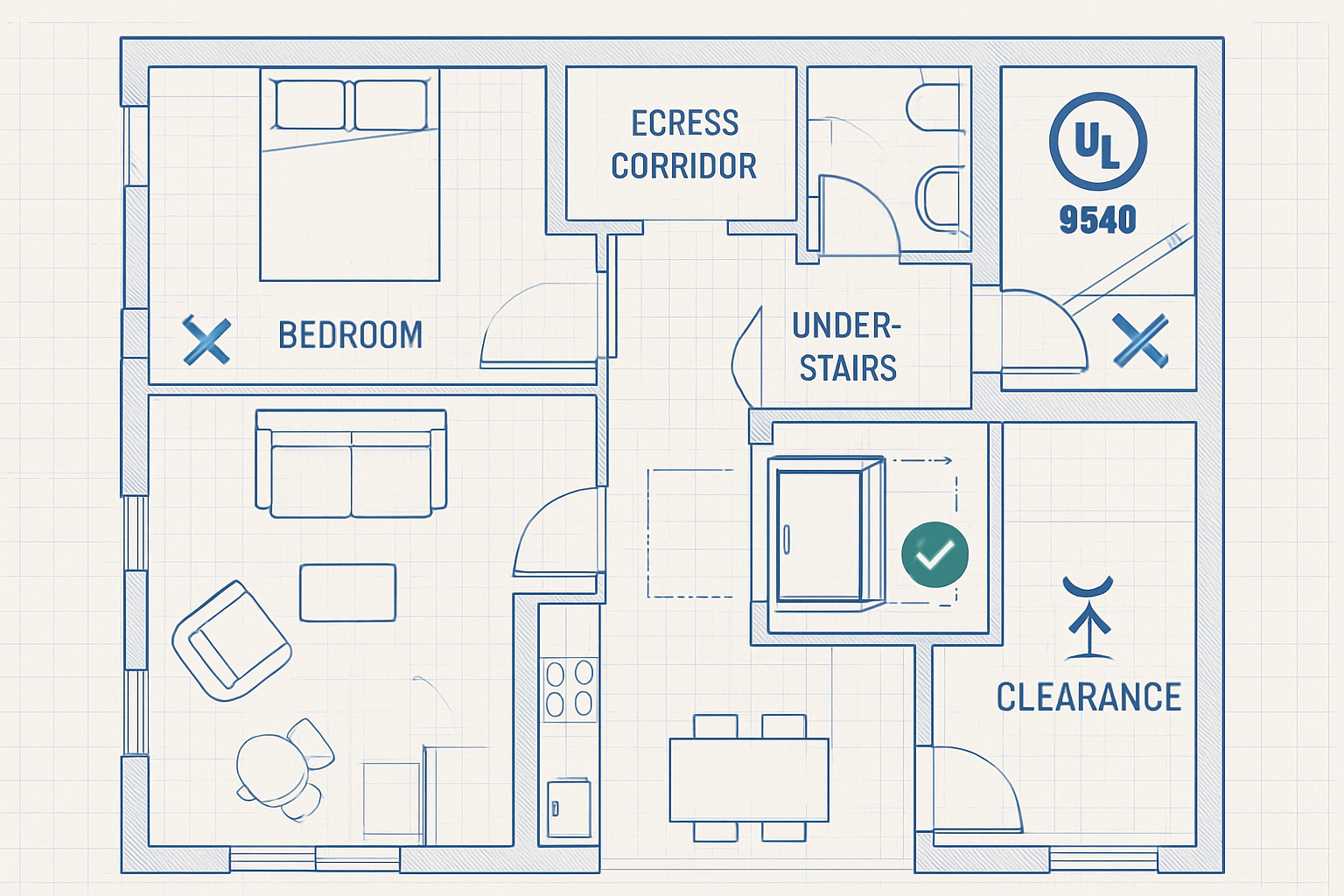Balcony solar is growing fast. Tenants and condo owners like the simple plug-in kits and modest power gains. Safety questions follow. The big one: do balcony solar panels raise fire risk? Short answer: the risk can be low with listed equipment, correct wiring, and code-aware placement. This piece separates rumor from technical reality, and maps what apartment fire codes expect.

Myths vs facts: what actually causes PV-related fires
DC arc faults and connector issues
Most PV fire incidents start with a poor electrical connection. Loose, mismatched, or damaged DC connectors can arc under load. Balcony kits using microinverters or AC modules reduce DC voltage on the balcony, which cuts arc energy. Use matching, listed connectors and follow polarity. Do not mix connector families. Look for IEC 62852-compliant connectors and modules certified to UL 61730.
Hot spots from shading and damage
Broken cells, cracked glass, or heavy partial shading can create local hot spots. Quality modules include bypass diodes and thermal testing in certification. Still, avoid sharp bends, heavy objects on panels, and sustained shading from grills or furniture.
Inverters, cables, and overcurrent protection
Inverters run cooler with airflow and correct loading. Keep microinverters behind the module but not trapped against combustible surfaces. Use outdoor-rated cable (UV and wet-location listed), drip loops, and strain relief. Protect circuits with the right fusing and ground-fault devices. For plug-in balcony kits, use a GFCI/AFCI-protected outlet and follow the manufacturer’s maximum backfeed rating.
Do balcony solar panels increase residential solar fire risk?
Balcony systems are small. Typical arrays are 200–800 W. With microinverters, DC voltage stays near module level (30–60 V). That’s far lower than string systems that can run 300–600 V DC. Less voltage means less arc energy.
- Use listed AC modules or microinverters (UL 1741). This adds rapid shutdown and ground-fault protection by design.
- Limit to one or two circuits per outlet per the installation manual. Do not daisy-chain through power strips.
- Keep modules clear of fabric, decorations, and storage. Treat panels as electrical equipment, not shelves.
Risk comes from choices, not from panels alone. Good gear and clean cable work make the difference.
Apartment fire codes and how they apply
Codes vary by city and by building. The principles are consistent: keep exits clear, control combustibles, and use listed electrical equipment. Coordinate early with the property manager and the local Authority Having Jurisdiction (AHJ). Non-legal advice.
Egress, access, and combustibles
- Keep a clear path on the balcony. A common target is a 36 in (≈0.9 m) unobstructed route to exits. Check your local rule.
- Do not block windows, doors, or fire department access. Keep modules below the railing top if wind or debris risk exists.
- Mount to the railing or a stand designed for exterior loads. Avoid improvised frames on wood that can dry out and char.
Structural and wind design
- Verify railing strength and attachment. Lightweight panels can still act like sails in gusts.
- Use anti-lift hardware and secondary retention (safety tethers) where allowed. Fasteners should be corrosion resistant.
Electrical code triggers
- Follow NEC Article 690 for PV circuits. Even small arrays need listed modules, inverters, and correct labeling.
- GFCI/AFCI protection is vital for plug-in balcony kits. Use only dedicated, outdoor-rated receptacles with in-use covers.
- Rapid shutdown (NEC 690.12) applies to rooftops. Microinverters inherently limit energized DC on the balcony and often satisfy rapid-shutdown functions.
Battery storage safety on premises
Many renters pair balcony solar with a small battery. Safer chemistries and certified systems reduce residential solar fire risk.
- Select systems certified to UL 9540, with thermal testing data per UL 9540A. Keep batteries in ventilated, noncombustible enclosures.
- LiFePO4 has a higher thermal runaway threshold than many NMC/NCA cells. Still, follow charge limits and temperature specs.
- Setbacks: keep batteries away from exits and soft furnishings. Many AHJs prefer at least 0.9–1.0 m from egress paths. Confirm local rules.
Codes evolve. AHJs rely on listed equipment and documented setbacks. Clear drawings and a simple one-line diagram speed approvals.
Safer balcony configurations: pros and trade-offs
| Configuration | Typical DC voltage | Key fire vectors | Code triggers | Practical tips |
|---|---|---|---|---|
| AC module or panel + microinverter (plug-in) | 30–60 V DC (module only) | Connector mismatch, pinched cable | NEC 690 labeling, GFCI outlet | Use UL 1741 inverters, outdoor-rated cord, drip loops |
| Portable folding panel + portable power station | 16–50 V DC | Damaged folding hinges, unlisted adapters | ESS listing if used indoors | Use matched cables, keep battery off exits, charge at conservative rates |
| Small DC-only panel to DC load | 16–60 V DC | Unfused circuits, reverse polarity | Overcurrent protection | Add inline fuse near source, verify polarity, weatherproof all junctions |
Wiring and placement that reduce fire hazard
Good terminations and routing
- Always mate identical connector types. Seat fully with an audible click.
- Strain-relief every 12–18 in where cables move. No tight bends. Add UV-rated clips.
- Form drip loops. Keep connections off the floor to avoid standing water.
Clearances that help
- Leave a gap behind modules for airflow. Warm components age faster.
- Keep at least 0.3–0.5 m from fabrics, screens, and decorations. No covering panels with cloth or plants.
- Mount in line with railing posts to reduce snag risk. Avoid overhanging corners.
Monitoring and maintenance
- Check for connector browning, cracked backsheets, or swollen junction boxes every 3–6 months.
- Use inverter apps to spot unusual drop in output, which can flag a failing connection.
- After wind events, inspect mounts and recheck torque per the manual.
Why codes care: sector data and the compliance signal
Policy and investment trends highlight more small-scale PV and storage near homes. That drives closer inspection by AHJs and insurers.
- According to the IEA Energy Investment 2023 assessment, utility-scale solar approvals rose, reaching over USD 180 billion in 2022, while wind approvals fell, signaling more PV growth. See IEA Energy Investment 2023.
- Battery storage spending more than doubled in 2022 to above USD 20 billion, with the United States, China, and Europe accounting for the vast majority; 2023 was set for rapid growth. Source: IEA Energy Investment 2023.
- New US policy support can lower storage capital costs by nearly 15%, improving economics and adoption. Reference: IEA Energy Investment 2023.
- IEA’s 2024 outlook shows solar generation rising sharply by 2030 with increasing variable output, which pushes more distributed PV and careful interconnection. See IEA Renewables 2024.
- The US Solar Futures research on Energy.gov projects large growth in PV and storage capacity, emphasizing coordination, smart inverters, and safety-enabled interconnection.
| Indicator | 2016–2021 trend | 2022 | Notes |
|---|---|---|---|
| Utility-scale solar FIDs | Rising | ~USD 180B | Higher PV share vs wind approvals (IEA) |
| Battery storage investment | Rapid growth | > USD 20B | Set to grow again in 2023 (IEA) |
| Grid digital/EV infra spend | Increasing | Up in major economies | Supports distributed PV management (IEA) |
Takeaway: more PV and storage means more attention to clearances, listings, and emergency access on balconies. Good documentation and product labels smooth approvals.
Practical, code-aware setup checklist
- Choose equipment: modules with UL 61730, microinverter with UL 1741, battery (if used) with UL 9540. Ask for UL 9540A summary for thermal behavior.
- Mounting: use corrosion‑resistant brackets, stop-lift hardware, and safety tethers. No wood-only frames.
- Cabling: IEC 62852 connectors, outdoor-rated PV cable, drip loops, strain relief, and proper polarity. No adapters from unknown sources.
- Protection: GFCI-protected exterior outlet with in-use cover. Dedicated circuit preferred. Follow nameplate backfeed limits.
- Clearances: maintain egress width, keep 0.3–0.5 m from combustibles, and keep batteries away from exits.
- Labels and docs: add shutdown label at the plug or switch. Keep datasheets, certification pages, a one-line diagram, and a photo of the final install for the landlord and AHJ.
- Operating limits: avoid charging batteries above recommended C-rate. Follow temperature limits. Do not cover panels.
Key takeaways
Balcony solar panels are not a fire hazard by default. Risk concentrates in poor connectors, bad mounts, and blocked egress. Use listed equipment, mount securely, maintain clearances, and document the setup. Pairing with a listed, well-placed battery can be safe under modern apartment fire codes.
FAQ
Are balcony solar panels legal in apartments?
It depends on local code and lease terms. Many AHJs allow small, listed systems that keep exits clear and use proper wiring. Submit a simple packet with product listings, a layout photo, and a one-line diagram. Non-legal advice.
Do microinverters actually reduce fire risk?
Yes. They keep DC voltage at the module level, which limits arc energy and adds integrated ground-fault and rapid-shutdown functions. Use UL 1741 listed devices.
Is LiFePO4 safer than NMC/NCA for indoor apartment batteries?
LiFePO4 cells have higher thermal stability and typically lower heat release in abuse testing. Still, use a UL 9540 system, a vented metal enclosure, setbacks from exits, and conservative charge rates.
Can I plug a balcony PV kit into any outlet?
Use an outdoor GFCI receptacle with an in-use cover. Follow the inverter’s backfeed limits and your utility rules. Do not use power strips or daisy chains.
Will insurance object?
Insurers look for listed gear and no blocked egress. Provide equipment certificates and photos. Keep an inspection checklist on file.
References
- IEA, Energy Investment 2023: https://www.iea.org/reports/world-energy-investment-2023
- IEA, Renewables 2024: https://www.iea.org/reports/renewables-2024
- U.S. Department of Energy, Solar Energy: https://www.energy.gov/topics/solar-energy
- U.S. Energy Information Administration: https://www.eia.gov/
- International Renewable Energy Agency: https://www.irena.org
Disclaimer: Safety and code topics here are provided for general information. This is not legal, code, engineering, or insurance advice. Always consult your AHJ, landlord, and a qualified electrician.





Leave a comment
All comments are moderated before being published.
This site is protected by hCaptcha and the hCaptcha Privacy Policy and Terms of Service apply.